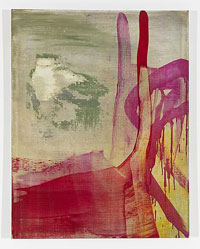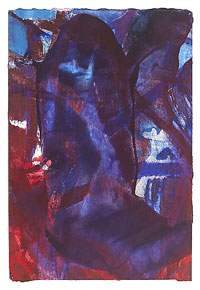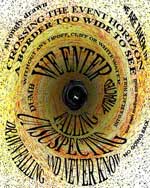|
Bill Jensen
at Cheim and Read

Bill Jensen: Linen
by Juan Seoane Cabral

There is an ancient Chinese story in which a sage
is asked by one of his disciples about
transcending the self. As a reply, the sage said
"You have heard the music of people, but not the
music of earth. And if you have heard the music of
earth, you haven't heard the music of heaven. When
the great earth breathes, we call it wind. When
the wind blows, all the holes in nature roar with
sound. Initially the wind sings one note; what
follows sings another note to harmonize. Gentle
breeze whispers softly; gusty wind bellows loudly.
The disciple asked further, "The music of earth
comes from all the openings in the wilderness; the
music of people is from flutes and musical
instruments. What about the music of heaven?" The
sage replied, "All these thousands of different
sounds are produced by different shapes of the
holes that the wind blows through. What made them
that way? What do you suppose is the activating
force behind it all?"
The story ends with this open question. The sage,
aware of the expectations of his disciple, decides
not to give more explanations so he can ponder
this question by himself.
I found one possible answer in the recent
paintings by Bill Jensen. In his art works I see
an artist who thought through the statement made
by Jackson Pollock, "I am nature." The meaning
behind this statement appears now to be that in
order to create a truthful and organic artwork the
artist has to become an embodiment of all the
rhythms, harmonies and even the contradictions
inherent in nature.
 In Bill Jensen's works there is a sensible
dialogue between the artist and the elements of
painting. Color, brushwork, surface and scale are
entirely accepted as living organisms. In
acknowledging these independent lives, the artist
is not forcing them into any direction. In front
of the artwork the artist knows that its plastic
values are universal and timeless. The
satisfactions of representational art are left
behind and substituted for the challenge of
pairing the life of the artwork that now presents
itself not only as an image but as a force of
nature.
In Bill Jensen's works there is a sensible
dialogue between the artist and the elements of
painting. Color, brushwork, surface and scale are
entirely accepted as living organisms. In
acknowledging these independent lives, the artist
is not forcing them into any direction. In front
of the artwork the artist knows that its plastic
values are universal and timeless. The
satisfactions of representational art are left
behind and substituted for the challenge of
pairing the life of the artwork that now presents
itself not only as an image but as a force of
nature.
If we can see some references to nature is not
because the painter is looking outside in order to
create these images. The same way the musical
composer doesn't necessarily need to listen to the
sounds of music in nature in order to compose, the
artist creates complex imagery by seeing within
himself the wide-open wilderness that has been
growing inside of him for all his artistic life.
Questioning the same manifestation of his images,
Bill Jensen goes further into detail to relate to
Universal truisms. In his artworks the act of
painting is not so much about painterly process as
it is about the all time existential exploration
of what lies underneath the universal cycles of
creation and destruction.
(Bill Jensen at Cheim and Read Feb 18 - Mar 27)
Juan Seoane Cabral is an artist and writer living
in New York and is a contributing editor and writer to
Artezine.
|







